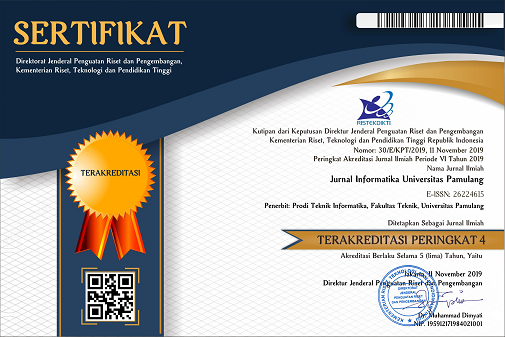Signature File Analysis Using The National Institute Standard Technology Method Base on Digital Forensic Concepts
DOI:
https://doi.org/10.32493/informatika.v5i3.6073Keywords:
digital evidence, digital forensics, signature file, investigation process, winhexAbstract
The number of crimes committed by utilizing advances in information technology such as information leakage, embezzlement of money in banks, credit card fraud, pornography, terrorism, drug trafficking and many more are definitely related to the name digital data. File signatures or magic numbers are one of the forensic science techniques that assist in processing this digital data. The method used in this research is the National Institute Standards Technology method to analyze the authenticity of digital data and the method of proof to obtain valid evidence during the identification process of data or file content. This research is presented in the form of an analysis of the use of signature files in investigations to determine the type of file in the case of leaking company information xyz, the research stage uses evidence handling procedures in the laboratory. Contributions made after conducting a series of case investigations using signature files have been successfully carried out using the Access Data FTK Imager application version 4.2.0 and WinHex version 18.6. Signature files can be used for case investigations in identifying and verifying file types so that files that have been modified can be restored and can be read by the operating system by checking file types through hexadecimal values in the header file (file prefix) that show the characteristics of each type file so that the file type can be found and the file can be read by the operating system.
References
Du, X., Le-Khac, N. A., & Scanlon, M. (2017). Evaluation of digital forensic process models with respect to digital forensics as a service. European Conference on Information Warfare and Security, ECCWS, 573–581.
Europol. (2017). Crime in the age of technology. Europol Unclassified - Basic Protection Level.
Harran, M., Farrelly, W., & Curran, K. (2018). A method for verifying integrity & authenticating digital media. Applied Computing and Informatics, 14(2), 145–158. https://doi.org/10.1016/j.aci.2017.05.006
Khan, M. A., Nasir, A., Ali, M. N., & Farooq, U. (2016). Crime Detection using Digital Forensic Technology. International Journal of Computer Science and Information Security (IJCSIS), 14(10), 487–506.
Maslin, N. M., Consultant, P., & Ltd, S. S. (2018). Impact of Modern Technology. HF Communications:, 3, 33–35. https://doi.org/10.4324/9780203168899_chapter_10
Noroozi, E., Daud, S. M., & Sabouhi, A. (2015). Secure Digital Signature Schemes based on Hash Functions. International Journal of Computer Engineering and Sciences, 1(1), 27. https://doi.org/10.26472/ijces.v1i1.18
Nugis, R. (2018). Forensic Data Properties of Digital Signature BDOC and ASiC-E Files on Classic Disk Drives.
Ramadani, S., Siahaan, A. P. U., Sutrisno, Ritonga, S., Amelia, W. R., Dalimunthe, H., & Munthe, R. (2018). Impact of Cybercrime on Technological and Financial Developments. International Journal For Research in Multidisciplinary Field, 4(10), 341–344.
Riadi, I., Yudhana, A., & Putra, M. C. F. (2018). Akuisisi Bukti Digital Pada Instagram Messenger Berbasis Android Menggunakan Metode National Institute of Justice (Nij). Jurnal Teknik Informatika Dan Sistem Informasi, 4(2), 219–227. https://doi.org/10.28932/jutisi.v4i2.769
Ruuhwan, R., Riadi, I., & Prayudi, Y. (2017). Evaluation of integrated digital forensics investigation framework for the investigation of smartphones using soft system methodology. International Journal of Electrical and Computer Engineering, 7(5), 2806–2817. https://doi.org/10.11591/ijece.v7i5.pp2806-2817
Sammes, T., & Jenkinson, B. (2007). Forensic Coputing A Practionier’s Guide.
Sitompul, O. S., Handoko, A., & Rahmat, R. F. (2018). File reconstruction in digital forensic. Telkomnika (Telecommunication Computing Electronics and Control), 16(2), 776–794. https://doi.org/10.12928/TELKOMNIKA.v16i2.8230
Umar, R., Riadi, I., & Muthohirin, B. F. (2019). Live forensics of tools on android devices for email forensics. Telkomnika (Telecommunication Computing Electronics and Control), 17(4), 1803–1809. https://doi.org/10.12928/TELKOMNIKA.v17i4.11748
Yudhana, A., Riadi, I., & Anshori, I. (2018). Analisis Bukti Digital Facebook Messenger Menggunakan Metode Nist. It Journal Research and Development, 3(1), 13–21. https://doi.org/10.25299/itjrd.2018.vol3(1).1658
Downloads
Published
Issue
Section
License
Authors who publish with this journal agree to the following terms:
- Authors retain copyright and grant the journal right of first publication with the work simultaneously licensed under a Creative Commons Attribution-NonCommercial 4.0 International (CC BY-NC 4.0) that allows others to share the work with an acknowledgement of the work's authorship and initial publication in this journal.
- Authors are able to enter into separate, additional contractual arrangements for the non-exclusive distribution of the journal's published version of the work (e.g., post it to an institutional repository or publish it in a book), with an acknowledgement of its initial publication in this journal.
- Authors are permitted and encouraged to post their work online (e.g., in institutional repositories or on their website) prior to and during the submission process, as it can lead to productive exchanges, as well as earlier and greater citation of published work (See The Effect of Open Access).
Jurnal Informatika Universitas Pamulang have CC-BY-NC or an equivalent license as the optimal license for the publication, distribution, use, and reuse of scholarly work.
In developing strategy and setting priorities, Jurnal Informatika Universitas Pamulang recognize that free access is better than priced access, libre access is better than free access, and libre under CC-BY-NC or the equivalent is better than libre under more restrictive open licenses. We should achieve what we can when we can. We should not delay achieving free in order to achieve libre, and we should not stop with free when we can achieve libre.
Jurnal Informatika Universitas Pamulang is licensed under a Creative Commons Attribution-NonCommercial 4.0 International (CC BY-NC 4.0)
YOU ARE FREE TO:
- Share : copy and redistribute the material in any medium or format
- Adapt : remix, transform, and build upon the material for any purpose, even commercially.
- The licensor cannot revoke these freedoms as long as you follow the license terms





